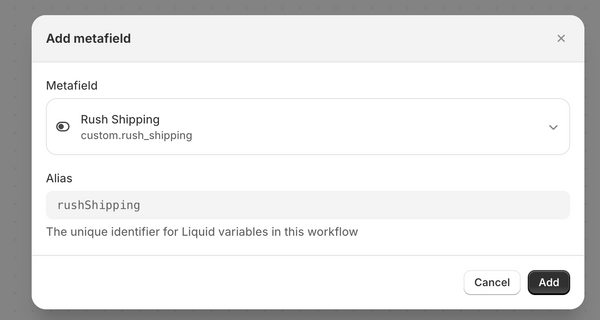All the Shopify updates and changes for April
- Olly Green
- Read time: 9 minutes

There were a host of updates, changes, and improvements rolled out for Shopify over the course of April. We’ve rounded up all the new capabilities you will be able to utilise to enhance your store.
Collective product publishing streamlined
Undeliverable state adjustments for Markets Pro
Toggle for preferential treaties
Shopify App tweaks and enhancements
Redirect after Form submission
Fresh default layout for Smart Grid
Simplified metafield access and integration
'Ship to customer’ workflow improved
Set default address on Shop Pay
Collective product publishing streamlined
Product status can now be managed directly within Collective, streamlining the publication of products and allowing for a faster go-live.
Collective Retailers now have the ability set to ‘Imported products’ to ‘active’ within their Collective connection. Up to 30 products can be selected at a time, meaning Retailers no longer need to manage ‘imported product’ status in their Core Products page.
Undeliverable state adjustments for Markets Pro
There have been adjustments released for packages in an ‘undeliverable’ state on Markets Pro labels. Merchants will see these adjustments in Payouts and further details will be available in Order timeline events.
Packages may be undeliverable if:
- It has an incomplete, illegible, or incorrect customer address
- It can’t be cleared by customs
- It is rejected by the customer before opening
- It contains prohibited items
The reason for a package being undeliverable, the carrier, and the location of the package will dictate the outcome, which may be:
- The package is redirected
- The package is returned to origin
- The package is abandoned

Each of these outcomes typically incur a fee, which is detailed in Payouts and Order timeline events.
Toggle for preferential treaties
There is now the capability to toggle whether preferential treaties – also known as free trade agreements (FTAs) - are used in Duties and Import Taxes calculations at checkout.
Preferential treaties are agreements between two or more countries that see duties on certain products lowered or eliminated – if certain requirements are met.
If you are unable to meet these requirements, you can disable preferential treaties on the Duties and Taxes settings page. This will mean the calculator reverts to the country's most-favoured-nation (MFN) duty rate.
Shopify App tweaks and enhancements
There were several upgrades made to the Shopify App for IOS and Android in April:
Long press behaviour update
There is now consistent long press behaviour to Orders and Products across the Abandoned Checkouts Index, Collections Index, Customer Index, Customer Addresses List, and Customer Segments Index. Many of these screens now also include filtering and sorting.
Long press allows you to easily perform actions on multiple list items at once.
Simpler collection edits
The collection details flows can now be viewed, created, and edited from a single screen that has similar sections and saving behaviour as the product details screens.
This has improved consistency and reduced the number of taps it takes to create or edit a collection.

'Add Customer' flow improvement
There is now more consistency across the iOS and Android apps for the Add Customer flow. On iOS, merchants can now add notes and tags, and search for and sort customer tags.
This makes sharing notes about a customer and adding tags while on the go much simpler. It also means that those notes and tags are accessible regardless of the platform from which a staff member views customer details from.
New Customer Segment Details support
Customer Segment Details screens are now also more consistent across iOS and Android, with merchants able to send discounts and email campaigns, edit segment queries, and duplicate and export segment details from the Shopify app.
Redirect after Form submission
Instead of receiving a success message, customers can now be directed to a specific page, such as a product page or collection, after they successfully submit a form. They may alternatively be directed to next steps for B2B contacts, or special perks exclusive to email subscribers.
New max value for gift cards
From May 15, there will be a new maximum value of $2,000USD (or equivalent) added to issued gift cards. This allows for compliance with laws surrounding gift cards.
The new maximum value will not affect gift cards issued before May 15.

Fresh default layout for Smart Grid
The default Smart Grid tile layout for new locations has been updated within the POS app. The new five-tile layout, which can still be customised and updated, will feature the following options:
- Custom Sale
- Apply Discount
- Ship All Items
- Email to Customer
- Save as Draft Order
‘Ship from store’ fulfillment
A new ‘Ship from store’ fulfillment workflow, which was showcased in Shopify Winter Editions ‘24, allows retail staff to fulfill online orders assigned to retail location directly from POS.
Retail staff previously needed access to Shopify Admin to execute order fulfillment, but will now be able to pick, pack, and ship orders if they are permissioned. Orders due for shipping will be surfaced under the Orders tab.
After configuring ‘Ship from store’, staff will be able to navigate to an assigned order and tap ‘Prepare for shipping’ before using a barcode scanner to check off items.
'Buy X Get Y' discount codes
Shopify POS now offers ’Buy X Get Y’ discount codes, enhancing in-store selling and promotional strategies. All admin-defined discounts are now supported on POS.
Manage POS device language
The product language displayed on your POS devices can now be customised, catering for the local language of each retail location and allowing for a localised experience for staff and customers.
POS devices and receipts will automatically display product translations configured in your POS channel when a language is specified for a retail location.
Simplified metafield access and integration
Metafield values can now be checked more easily in the Flow app. Select from a list of known metafields for each resource – such as products and orders – to generate an Alias. This allows Flow to get the metafield data and can be used in subsequent steps and liquid. This variable will then appear in a group titled Fields with Arguments.


This update negates the need to loop over the metafields list on resources, which when accessed could cause performance issues. This method is being deprecated from the app amid the update.
Meanwhile, the Online Store Editor now supports market metafields as a dynamic source, allowing the seamless integration of Market Metafields into storefronts and furthering customisation and functionality of online stores for different markets
'Ship to customer’ workflow improved
The ’Ship to customer’ workflow has been updated to allow staff to amend shipping orders in the cart – such as adjusting product items or quantities - without losing in-progress information. It previously wasn’t possible to edit or exit the cart until a purchase was completed.
Duplicate existing forms
Shopify Forms now supports the duplication of previous forms when using Shopify Forms. Save time, ensure consistency across forms for different pages, and replicate successful structures by creating modified versions of existing forms.
Duplicated forms retain the original fields, settings, and configurations
Set default address on Shop Pay
Customers using Shop Pay can now streamline their checkout experience by setting a default address. This can be done either during checkout or through the Shop app. This feature is likely to reduce order cancellations due to incorrect shipping addresses.
Return rules support in POS
POS now includes return rules, which are structured policies that can be used for returns made either in-store or self-served online. This reduces the demand on staff to make decisions on returns and ensures consistency across the process.
Return rules can be configured in the Shopify Admin – saved policies then determine a product’s eligibility when it is added to a return. POS will surface additional context to staff when a product is ineligible. Managers with associated permissions can override policies to complete a return or exchange if necessary.
Get in touch with our experts if you're considering making the switch to Shopify and want to know how the latest updates and changes could improve your offering.